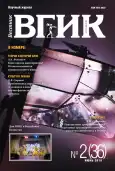Том 10, № 2 (2018)
- Год: 2018
- Статей: 15
- URL: https://journals.eco-vector.com/2074-0832/issue/view/870
- DOI: https://doi.org/10.17816/VGIK102
ХРОНИКА В ДЕТАЛЯХ | АКТУАЛЬНОЕ СОБЫТИЕ
Юбилейные торжества ВГИК. Визит в Республику Казахстан
Аннотация
Юбилейные торжества в честь 100-летия Всероссийского государственного института кинематографии имени С.А. Герасимова (ВГИК), одной из ведущих киношкол мира, начались. Официально дата празднования приходится на 1-е сентября 2019 года, но подготовка к знаковому юбилею идет полным ходом. Первой среди зарубежных чествований знаменитой киношколы стала Республика Казахстан, где в Астане и Алматы состоялись «Дни ВГИК», организованные Министер-ством культуры и спорта Казахстана
 6-6
6-6


ТЕОРИЯ И ИСТОРИЯ КИНО | ЭКРАННЫЕ ИСКУССТВА
Кино против авангардизма? Об онтологичности художественного языка
Аннотация
В начале XX века происходят две революции в мире искусств: появление авангарда и рождение киноискусства. Авангард в живописи, архитектуре, литературе завершает процесс ««онтологизации» художественного производства и ставит окончательный акцент в этом макроисторическом развитии. Новорожденное искусство кино, имея иные идейные задачи, как бы замещает через ««человеческое изменение» функции, отменяемые в искусстве авангарда, и предлагает зрителю развлечение, поучение, эмоциональные разрядки. В статье рассматриваются процессы стихийной онтологизации, воспроизведение социально-инструментальным киновысказыванием того онтологического нарратива, который разворачивается в 1910-е годы в новом авангардном искусстве. Анализируются также художественные средства и методы раннего кинематографа, во многом превосходящие авангардные средства выражения в других видах искусства.
 8-26
8-26


Продукт киноиндустрии - культурное благо в форме товара
Аннотация
Рассматриваются сущностные особенности кинофильма как продукта киноиндустрии. В центре внимания - противоречие между духовно-культурной потребительной стоимостью продуктов киноиндустрии и товарной формой их производства и потребления. Затрагиваются связанные с этим проблемы самовыражения и воспроизводства культурной идентичности нации средствами кино, защиты культурного разнообразия.
 27-36
27-36


КИНОЯЗЫК И ВРЕМЯ | ГЕНЕЗИС ОБРАЗА
Кинометаморфозы Ивана Пырьева
Аннотация
Статья посвящена творчеству Ивана Пырьева - личности неоднозначной и удивительно талантливой. Режиссер, сценарист, организатор кинопроизводства, он оставил богатое творческое наследие. Его музыкальные комедии 1930-1940-х годов - шедевры «народного фильма» эпохи социалистического реализма. А экранная интерпретация произведений Достоевского - не только интересный эксперимент советского кино, но и школа мастерства.
 38-48
38-48


ПЕРФОРМАНС | ИСКУССТВО ВОПЛОЩЕНИЯ
Эстетика интерактивности: между игрой и фильмом. Смотреть или играть?
Аннотация
Во второй части статьи (окончание, начало в № 1 (35), 2018) рассматривается влияние видеоигровой индустрии на язык современного кинематографа с точки зрения эстетической формы, анализируются психологические аспекты кинолент, опирающихся на игровое мышление человека, а также визуальные приемы, воссоздающие гейм-ассоциации при просмотре. Разбирается новаторский формат полнометражного интерактивного фильма, во время которого зритель сам управляет развитием сюжета и отношениями между героями в рамках заданных правил.
 50-60
50-60


КУЛЬТУРА ЭКРАНА | КУЛЬТУРОЛОГИЯ. ФИЛОСОФИЯ
Проблематика диалектики тела и сознания в новейших научно-фантастических сериалах
Аннотация
В статье анализируются научно-фантастические сериалы новейшего времени в контексте философской проблематики связи тела и сознания. Для анализа используется синтез теоретического знания и феноменологического, психоаналитического, нейрофизиологического, а также кибернетического опыта. Перспектива разработки искусственного интеллекта, включая попытки ««пробуждения» самосознания у роботов, актуальны в настоящее время не только для научной фантастики, но и для реальной действительности, что и объясняет высокий рейтинг современной кинопродукции в жанре ««киберпанк».
 62-71
62-71


ЧИТАЛЬНЫЙ ЗАЛ | КНИЖНАЯ ПОЛКА
 72-72
72-72


МИРОВОЙ КИНОПРОЦЕСС | АНАЛИЗ
Влияние традиций национальной культуры на приемы звукорежиссуры в японском кинематографе. Речь и пауза
Аннотация
В статье (окончание, начало в № 1(35), 2018) анализируются звуковые особенности японских кинофильмов, созданных во второй половине ХХ - начале XXI века. Прослеживаются причины воздействия на звуковые решения традиций речевой выразительности актерской школы национального театра. Представлены стилистические, фонетические и семантические особенности актерской речи в японских кинокартинах костюмно-исторического жанра (дзидайгэки), а также в фантастических и анимационных фильмах.
 74-84
74-84


Кинематографическая саморефлексия: классификация видов
Аннотация
Статья посвящена феномену кинематографической саморефлексии и квалификации ее видов, рассматриваемых на примере фильмов И. Бергмана ««Земляничная поляна», ««Час волка», ««Седьмая печать». Проводится разграничение между понятиями авторская саморефлексия и саморефлексия персонажа в кино, приводится классификация основных видов саморефлексии героев фильма.
 85-94
85-94


Психологизм ранних картин Асгара Фархади
Аннотация
В статье рассматриваются первые работы одного из ведущих современных иранских режиссеров Асгара Фархади. При анализе фильмов подтверждается, что режиссеру удалось развить эстетические завоевания иранской ««новой волны» 1990-х годов, сделать жанр психологической драмы одним из ведущих в современном иранском кино.
 95-106
95-106


КИНОБИЗНЕС | СТРАТЕГИЯ И ТАКТИКА УПРАВЛЕНИЯ
Финансирование кинематографии как высокорискового вида деятельности
Аннотация
В статье исследуются особенности финансирования кинематографии - одной из ведущих подотраслей культуры и искусства отрасли национальной экономики. Анализируются распространенные в отечественной и зарубежной практике методы и инструменты поддержки кинопроизводства. Раскрываются источники финансирования кинопроизводства, приводятся рекомендации по их применению в экономической деятельности. Обосновываются варианты активизации работы в сфере кинобизнеса, повышения доходности и снижения рисков венчурных проектов. Уделяется внимание развитию маркетинговых стратегий и рекламных бюджетов как необходимых элементов для активизации инноваций и инвестиционной деятельности в кинопроизводстве.
 108-121
108-121


Перспективы профессиональной подготовки продюсеров в контексте развития кинобизнеса в России
Аннотация
В статье раскрывается история введения в России одного из наиболее востребованных в рыночной экономике профессионального стандарта - подготовка продюсеров в области кино и телевидения. Рассматривается многоаспектность и междисциплинарность этой специальности при получении знаний в рамках образовательного процесса. Сопоставляются критерии подхода и методики обучения профессии в России и ряде зарубежных стран. Обусловливается необходимость введения в образование новых, сопряженных с продюсерством, специализаций в сфере кинопроизводства в связи с ускорением производственных процессов и развитием в России цифровой экономики.
 122-140
122-140


ТЕЛЕВИДЕНИЕ | ЦИФРОВАЯ СРЕДА
«Новая драма» в контексте исторического фильма
Аннотация
Статья повествует о месте и значении исторической темы в творчестве кинорежиссеров «новой драмы», рассматриваемой как часть проблемы формирования идентичности. Анализируется телесериал Кирилла Серебренникова ««Дневник убийцы» (2002) - философская картина, которая выходит далеко за рамки стандартной ТВ-продукции и представляет собой один из лучших современных фильмов о русской революции.
 142-151
142-151


SUMMARY | ПРЕЗЕНТАЦИЯ АВТОРОВ
 152-157
152-157


РЕКОМЕНДАЦИИ АВТОРАМ
РЕКОМЕНДАЦИИ АВТОРАМ
Аннотация
Научный рецензируемый журнал «Вестник ВГИК» является ведущим научным периодическим изданием Всероссийского государственного института кинематографии имени С.А. Герасимова. Решением Президиума Высшей аттестационной комиссии Минобрнауки России «Вестник ВГИК» включен в Перечень ведущих рецензируемых научных журналов и изданий, где публикуются основные научные результаты диссертаций на соискание ученых степеней доктора и кандидата наук, отвечающие требованиям ВАК по научным специальностям: «Искусствоведение»,«Философские науки». Рекомендации для авторов статей.
 158-160
158-160













